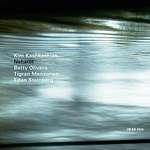|
Back
10/27/2009
Betty Olivero: Neharót Neharót (*)
Tigran Mansurian: Tagh for the Funeral of the Lord – Three Arias (Sung out the window facing Mount Ararat (**)
Komitas (arr. Mansurian): Oror
Eitan Steinberg: Rava Deravin (***)
Kim Kashkashian (viola), An Raskin (accordion), Philipp Jungk (percussion), Robyn Schulkowsky (percussion), Tigran Mansurian (piano), Munich Chamber Orchestra, Alexander Liebreich (conductor) (*), Boston Modern Orchestra Project, Gil Rose (conductor) (**), Kuss Quartet (***)
Recorded at: Himmerlfahrtskirche, München (03/08 [Olivero]), Aula Nova, Academy of Music, Poznań, Poland, (10/07 [Tagh, Komitas]); Jordan Hall, Boston, (01/06 [Steinberg]) & (05/08 [Arias]) – 60’13
ECM 2065 – Booklet in German and English

Kim Kashkashian continues her impressive, explorative career on this collection, performing music from off the beaten path by composers that deserve to be better known. The shear variety of contexts her exquisite viola sound is given is captivating, and her playing is, as always, the last word in finesse, dedication and high taste. This release is an important exploration of new paths and contains contemporary works that strike a nice balance between being challenging and instantly listenable.
Israeli composer Betty Olivero’s Neharót Neharót is extremely successful in creating timbral transformations, magically weaving chorale-like sonorities between two string ensembles, solo accordion and viola, metallic percussion and two prerecorded voices. The melodic focus is on highly ornamented passages that pre-echo the vocal gestures heard about 10 minutes in. Everything is pointing to “reveal”, when “Tu se’ morta” from Orfeo emerges, and the listener is reminded how uncannily Monteverdi’s florid vocal style matches Olivero’s instrumental writing and her singers’ prerecorded gestures. The title of the piece means “Rivers, Rivers”, and the work has a continuous, unfolding inevitability to it. The carefully layered dissonances, with pure triads rising to the surface and then being swallowed back up, are merged with measured harmonic rhythm and folk-derived melodic material, resulting in a creation that evokes a cross between Gubaidulina and Sibelius.
Tigran Mansurian’s Tagh for the Funeral of the Lord features melodic material similar Olivero’s work underscored by vibraphone and Thai gongs. Microtonal inflections in the viola heighten the folk-derived aspect of the piece. The progression from the rather complex timbres of Neharót Neharót to the Tagh and further to Mansurian’s solo piano reworking of Komitas’ Oror make a clear deconstruction of the melodic and harmonic material heard throughout the disc.
These are then clearly and extensively explored in the song-without-words Three Arias (Sung out the window facing Mount Ararat), in which the “emotion at the root…is one of longing, a feeling not so far from lament.” Constructed in easily followable structures, each is given a distinct character, with the central “Tranquillo, poco libero” providing a rhythmic lilt and sweet harmonic coloring that construes an overall feeling of bittersweet nostalgia. The three movements truly are “arias” for Kashkashian, with the Boston Modern Orchestra Project reveling in its sensitively-orchestrated figurations that support the violist’s effortless, perfectly phrased lyricism.
The disc finishes with Eitan Steinberg’s Rava Deravin, neatly balancing the opening Olivero work in length and emotional content, while presenting yet another engrossing compositional voice. Originally conceived as a vocal chamber work, Kashkashian is given the role of a wordless singer, floating in, out and around the accompanying string quartet gestures, which are at once delicately dissonant chorales and then fleeting, Bartókian night-music. The middle of the piece contains the only real “fast” music on the disc, the quartet producing a glassy river of motion that continues to support the viola’s melodic musings. Steinberg knows just how long to sit in each successive environment, and the piece has a wonderful, organic flow, complemented by a clear sense of “hope” and a particularly effective, bittersweet ending.
Performances are consistently excellent. While Kashkashian seems to have the same “role” in each work, the context shifts quite a deal as the program proceeds, and everyone involved adapts wonderfully. The recording follows suit, enrobing the viola in the rich sonic world of the Olivero piece and then separating it into a slight spotlight in the Mansurian and Steinberg works. All three ensembles accompanying Kashkashian are beautifully captured and adept at producing chimerical contexts for this truly otherworldly music. One can’t help but feel a sense of awe at the emotional power that these three composers, each from a part of the world that has seen much conflict and loss, bring to their art. This is raw, honest music-making and deserves a place in everybody’s playlist.
Marcus Karl Maroney
|